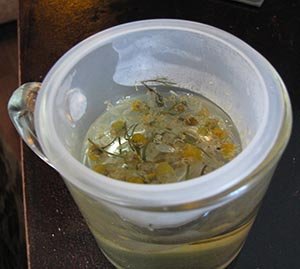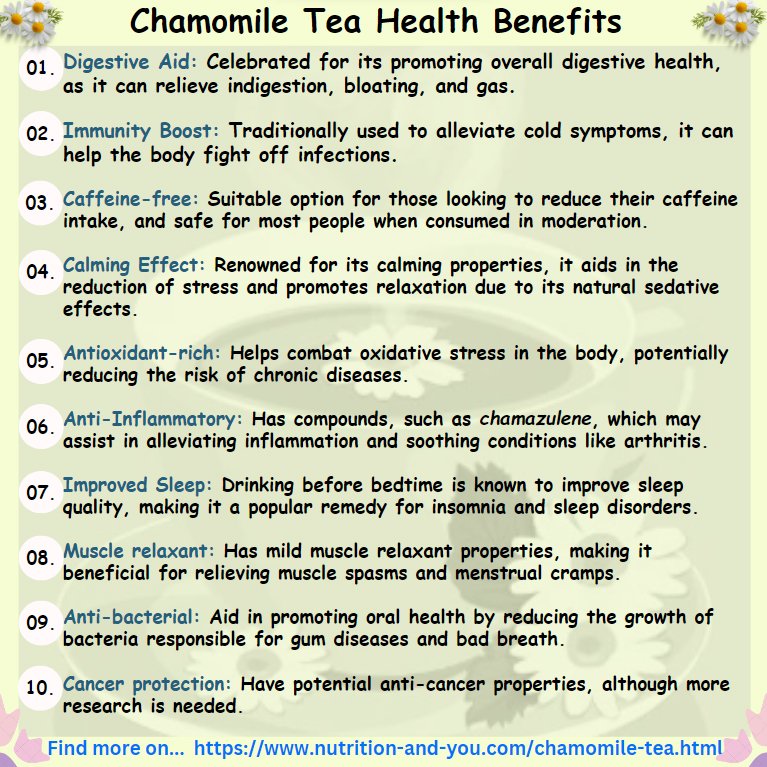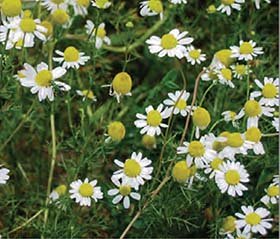Chamomile tea
Chamomile tea is a fragrant infusion of fresh or dried chamomile flowers. Since early Egyptian times, it has been used as a traditional strewing herb. It is one of the nine sacred herbs named in the Anglo-Saxon medical texts and prayers and praised as "plants' physician" for its healing abilities.
The herb belongs to the Asteraceae (daisy) family of flowering plants, which emit an apple-like aroma. Flowers are handpicked particularly during early morning hours for making herbal tea.

|
| Chamomile tea. Courtesy: Tory |
There are several varieties of chamomile grown naturally in the wild, under temperate climates of the Northern Hemisphere. However, the two most popular varieties cultivated for their flowers and herbal parts are German Chamomile (Matricaria chamomilla), and Roman Chamomile (Chamaemelum nobile).
The German (blue) Chamomile is an aromatic annual with branched stems up to 18 inches in height. Its stems are hairless, and slender, and bear small pleasantly fragrant white florets around the prominent orange-yellow disc. The disc (receptacle) is hollow and becomes conical as the flower matures.
Roman Chamomile is a vigorous hairy creeping perennial, up to 18 inches, with ferny leaves. Its flowers appear similar to the German chamomile but a little larger featuring a solid receptacle with sweet, fruity, apple-scented florets.
For cultivation, spread seeds in spring on fertile, well-drained, light soil. By summer, blooms can be ready for harvesting. For the purpose of essential oil and teas, its flowers have gathered as petals. Petals are allowed to wilt briefly in the sun and later slow-dried under shade.
Health benefits of Chamomile tea
Chamomile is one of the popular flower herbal teas consumed around the world, especially in Europe. Ancient Greeks used it to make wreaths and garlands who firmly believed it as a symbol of peace, harmony, and happiness.
Chamomile flowers carry several active chemical substances such as chamazulene, bisabolol, apigenin, and luteolin, etc. The flower extracts and the essential oil are therefore the ingredients of several traditional herbal remedies.
The flavonoids are mainly of apigenin with smaller amounts of luteolin and quercetin. Together, these compounds are known to work as anti-inflammatory and anti-bacterial properties.
The constituents in chamomile tea or tisane have refreshingly soothing effects on the nervous system, reduce nervous irritability, and induce calm and mildly sedative effects.
Its active ingredients also help stimulate the appetite and cleanse the blood.
Medicinally, the extraction obtained from both varieties of chamomile herbal parts is used for reducing skin inflammation, and erythematous lesions.
Quercetin in the infusion, in fact, protects the skin from sunlight injuries.
The herb carries very small amounts of minerals like iron, calcium, potassium, manganese, copper, and zinc.
 |
| Principle | Nutrient Value | Percent of RDA |
|---|---|---|
| Energy | 1 Kcal | <1% |
| Carbohydrates | 0.20 g | <1% |
| Protein | 0 g | 0% |
| Total Fat | 0 g | 0% |
| Cholesterol | 0 mg | 0% |
| Dietary Fiber | 40.3 g | 106% |
| Vitamins | ||
| Folates | 1 μg | 0.25% |
| Niacin | 0 mg | 0% |
| Pyridoxine | 0 mg | 0% |
| Riboflavin | 0.004 mg | <1% |
| Thiamin | 0.010 mg | <1% |
| Vitamin A | 20 IU | 0.7% |
| Vitamin C | 0 mg | 0% |
| Vitamin E | 0 mg | 0% |
| Vitamin K | 0 µg | 0% |
| Electrolytes | ||
| Sodium | 1 mg | <1% |
| Potassium | 9 mg | <1% |
| Minerals | ||
| Calcium | 2 mg | <1% |
| Copper | 0.015 mg | <1% |
| Iron | 0.08 mg | 1% |
| Magnesium | 1 mg | <1% |
| Manganese | 0.044 mg | <1% |
| Zinc | 0.04 mg | <1% |
| Phyto-nutrients | ||
| Caffiene | 1 mg | -- |
| Carotene-ß | 12 µg | -- |
| Cryptoxanthin-ß | 0 µg | -- |
| Lutein-zeaxanthin | 0 µg | -- |
| Theobromine | 0 µg | -- |
Harvesting and storage

|
| Beautiful chamomile flowers. |
Full blooms are either handpicked or harvested by hand-raking for the highest quality tea market. However, it is a very labor-intensive and costly process.
Shade-dried flowers are then sorted out for any foreign material, or debris before processing. Flowers are then carefully graded before selling in bulk to factories where they are further processed and packed in tea bags/sachets and small storage tins. Chamomile flowers and herb parts are also blended with other herb products.
Buy freshly harvested and shade-dried chamomile flower heads packed in tea bags or in airtight tins from the specialty herbal product store. Look for authenticity, and avoid any adulterated products.
Preparation of chamomile tea
German chamomile flowers for brewing tea give the infusion a delicate light blue color. German Roman chamomile, on the other hand, gives the infusion a delicate light straw color. Freshly harvested and shade-dried flowers should be used within 6 months for maximum health benefits.
Put the fresh or dried chamomile flowers into a teapot or directly into a mug. Pour on the boiling water and leave to infuse for about 5 minutes or longer if you prefer a stronger flavor. Strain the tea, and if you wish add a small amount of caster sugar or honey and stir to dissolve.
Here are some other serving tips:
Drink 1 to 4 cups of chamomile tea every day for long-lasting health benefits.
Chamomile is a caffeine-free tisane (herbal infusion) and works as a mild sedative. It can be enjoyed as a bedtime drink for sound sleep.
Fresh chamomile petals are also employed as a flavoring garnish in salads, soups, stews, marinades as well as in vegetable dishes.
Safety profile
Chamomile tea and other products may not be recommended in people with known sensitivities or allergies to the daisy or Asteraceae family plants such as chrysanthemums, ragweed, etc.
Chamomile products are also not indicated in patients with atopic hay fever or asthma. It is contraindicated in women during their early months of pregnancy due to its possible birth defects in the newborn. (Medical disclaimer).
Also read ≻≻-
≻≻- Lemon balm tea Health benefits.
≻≻- Rooibos tea Health benefits.
≻≻- Back to Herbal teas from Chamomile tea. Visit here for an impressive list of all variety of herbal tea with complete illustrations of their nutrition facts and health benefits.
≻≻- Back to Home page.
Further Resources:
USDA National Nutrient Database. (opens in new window).
Stanford School of Medicine Cancer information Page-Nutrition to Reduce Cancer Risk (Link opens in new window).
Introduction to chamomile-American Botanical Council. pdf. (opens in new window).
Chamomile (Matricaria chamomilla L.)-an overview.. pdf. (opens in new window).